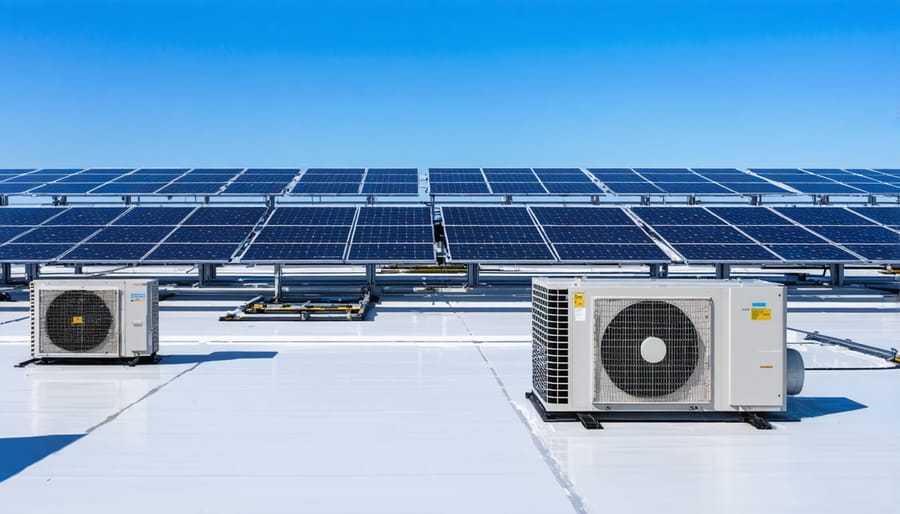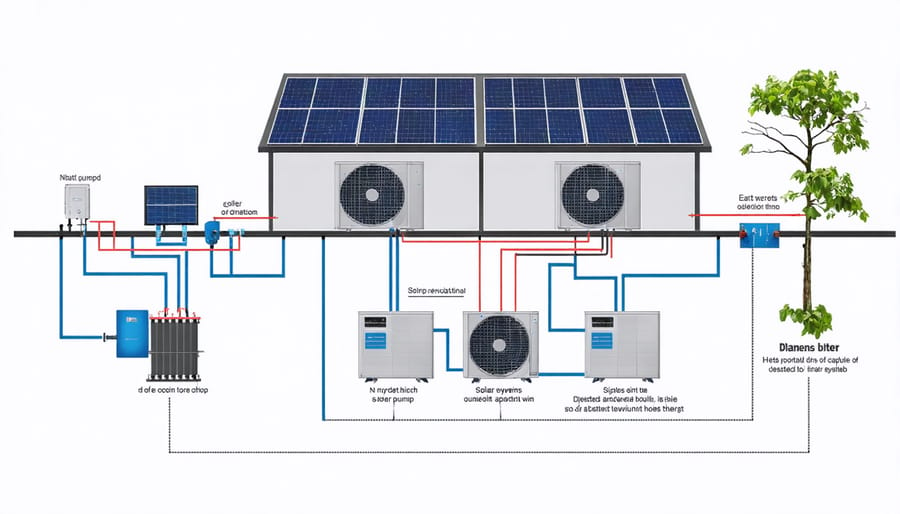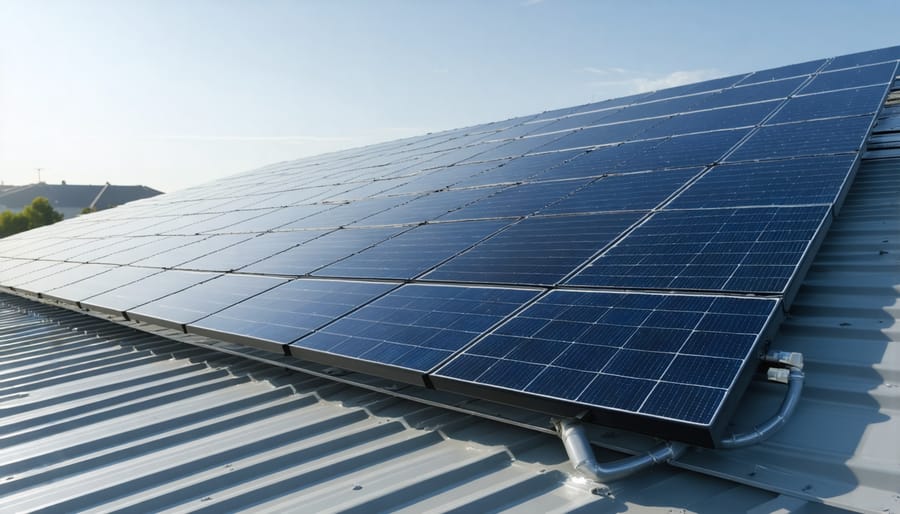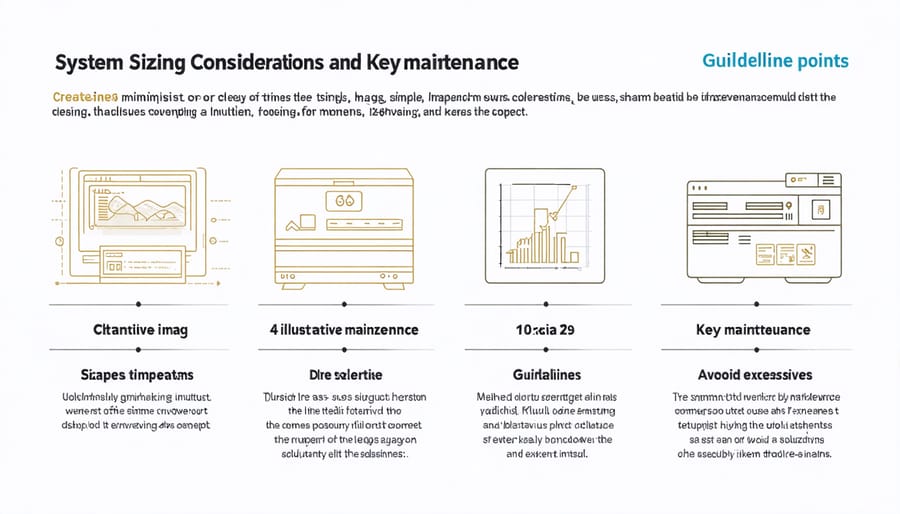Solar-Assisted Heat Pumps Are Revolutionizing Industrial Cooling (Here’s How)

Solar-assisted heat pumps represent a groundbreaking fusion of renewable energy and thermal technology, offering European industries a powerful solution to reduce energy costs while advancing sustainability goals. By harnessing solar thermal collectors to enhance traditional heat pump systems, these innovative installations can achieve remarkable efficiency gains of up to 50% compared to conventional heating and cooling methods.
In today’s climate-conscious industrial landscape, where energy efficiency directly impacts both environmental footprint and operational costs, solar-assisted heat pumps emerge as a compelling investment for forward-thinking facility managers. These systems excel particularly in regions with abundant solar resources, providing reliable temperature control while significantly reducing dependency on grid electricity.
The technology’s unique ability to integrate seamlessly with existing industrial processes makes it especially valuable for manufacturing facilities, food processing plants, and large-scale commercial operations across Europe. As energy prices continue to rise and environmental regulations tighten, solar-assisted heat pumps offer a pragmatic pathway to sustainable thermal management, delivering consistent performance even during periods of limited solar availability through their hybrid operational capability.
This advanced solution not only addresses immediate energy efficiency needs but also positions facilities at the forefront of sustainable industrial practices, aligning perfectly with EU climate targets and green energy initiatives.
How Solar-Assisted Heat Pumps Transform Industrial Cooling
Core Technology Components
A solar-assisted heat pump system integrates three essential components that work in harmony to maximize energy efficiency. The foundation begins with solar collectors, typically consisting of either flat-plate or evacuated tube designs, which are crucial for solar thermal power in manufacturing and residential applications. These collectors capture solar radiation and convert it into usable thermal energy, achieving collection efficiencies of up to 80% under optimal conditions.
The heat pump unit serves as the system’s core, utilizing a refrigeration cycle to amplify the harvested solar energy. Modern units employ advanced scroll compressors and eco-friendly refrigerants, achieving coefficient of performance (COP) values between 3 and 5, meaning they deliver 3-5 units of heat energy for every unit of electrical input.
Thermal storage systems complete the trinity, typically utilizing well-insulated water tanks or phase-change materials. These storage solutions maintain consistent temperatures and ensure system reliability during periods of low solar radiation. Advanced storage systems can retain heat for several days with minimal losses, featuring stratification technology that optimizes temperature layers within the storage medium.
The integration of these components is managed by sophisticated control systems that continuously monitor performance parameters and weather conditions, automatically adjusting operation modes to maximize efficiency while maintaining desired comfort levels.

Integration with Industrial Processes
Solar-assisted heat pumps can seamlessly integrate with existing industrial cooling infrastructure, offering enhanced efficiency and sustainability benefits. The integration process typically begins with a comprehensive assessment of the current cooling system, identifying optimal connection points and potential system modifications.
In industrial settings, these systems commonly interface with process cooling loops, chilled water networks, and refrigeration systems. The solar thermal collectors are strategically positioned to pre-heat the working fluid, reducing the energy load on conventional cooling equipment. This integration can be achieved through various configurations, including parallel operation, where solar energy supplements the existing system, or series installation, where solar heating becomes a primary energy source.
Modern control systems play a crucial role in managing the interaction between solar components and industrial processes. Advanced automation ensures smooth transitions between solar and conventional energy sources, maintaining stable operating conditions throughout production cycles. Buffer tanks and heat exchangers are often incorporated to balance load fluctuations and optimize energy distribution.
For European industries, the integration process typically involves modular components that can be scaled according to specific cooling requirements. This flexibility allows facilities to start with smaller installations and expand as needed, making the transition to solar-assisted cooling more manageable and cost-effective. The system’s compatibility with existing industrial standards and safety protocols ensures minimal disruption to ongoing operations while maximizing energy efficiency gains.
Key Benefits for European Industries
Energy Cost Reduction
Solar-assisted heat pumps offer significant cost reductions in energy consumption, making them an attractive investment for both residential and industrial applications. Studies across European installations show that these systems can reduce annual heating costs by 40-60% compared to conventional heating methods.
The primary cost benefit comes from the synergistic relationship between solar collectors and heat pumps. During sunny periods, the solar collectors provide free thermal energy, reducing the electrical input needed for the heat pump operation. Even in cloudy conditions, the collectors can extract ambient heat, improving the system’s overall coefficient of performance (COP).
In typical European climate conditions, a well-designed solar-assisted heat pump system can achieve payback periods of 4-7 years, depending on local energy prices and installation costs. The savings are particularly notable during spring and autumn when solar radiation is moderate and heating demands are significant. Annual maintenance costs are minimal, typically ranging from €150-300, while the system’s lifespan often exceeds 20 years.
For industrial applications, the cost benefits scale up proportionally, with larger installations offering even more attractive returns on investment through economies of scale.

Environmental Impact
Solar-assisted heat pumps represent a significant advancement in sustainable energy systems, offering substantial environmental benefits compared to conventional heating and cooling solutions. By harnessing solar energy alongside heat pump technology, these systems can reduce carbon emissions by up to 70% compared to traditional fossil fuel-based heating systems.
The environmental impact is particularly notable in their operational phase, where they significantly decrease reliance on grid electricity. A typical residential installation in Europe can prevent approximately 2-3 tonnes of CO2 emissions annually, equivalent to planting 100 trees. The systems’ ability to utilize renewable solar energy minimizes the environmental footprint while maximizing energy efficiency.
Furthermore, solar-assisted heat pumps contribute to circular economy principles by reducing primary energy consumption and utilizing naturally available resources. The technology’s long lifespan, typically 20-25 years, ensures sustained environmental benefits while minimizing waste associated with frequent system replacements. This longevity, combined with minimal maintenance requirements, makes them an environmentally responsible choice for European businesses and homeowners committed to sustainability goals.
Performance Optimization
Several key strategies can significantly enhance the performance of solar-assisted heat pump systems. Proper sizing and integration of components is crucial, with optimal matching between collector area and heat pump capacity ensuring maximum efficiency. Advanced control systems that continuously monitor and adjust operation based on weather conditions, energy demand, and storage levels can improve overall system performance by 15-25%.
Regular maintenance and system monitoring play vital roles in maintaining peak efficiency. This includes cleaning solar collectors, checking fluid levels, and ensuring proper insulation of all components. Implementation of smart defrost cycles and variable speed compressors can further optimize performance during different weather conditions.
Energy storage optimization is another critical factor. Modern systems utilize stratified storage tanks and advanced thermal management strategies to maximize solar energy utilization. Integration of weather prediction algorithms helps in preemptive system adjustments, reducing reliance on backup heating systems during cloudy periods.
For maximum reliability, incorporating frost protection measures and implementing redundancy in critical components ensures consistent operation throughout the year. These optimizations can result in seasonal performance factors (SPF) exceeding 4.0 in well-designed systems.
Implementation Considerations

System Sizing and Design
Proper sizing and design of a solar-assisted heat pump system requires careful consideration of several key factors to ensure optimal performance. The process begins with a comprehensive assessment of the building’s heating and cooling demands throughout the year, taking into account local climate conditions and seasonal variations.
For residential applications, the collector area typically ranges from 1.5 to 2.5 square meters per kilowatt of heat pump capacity. The solar thermal collectors should be oriented to maximize solar gain, ideally facing south in the Northern Hemisphere with an inclination angle between 30-45 degrees.
The heat pump capacity should be selected based on peak heating loads, while the solar thermal system is dimensioned to provide optimal support during transitional seasons. A well-designed buffer tank is crucial for system efficiency, with typical sizes ranging from 50-75 litres per square meter of collector area.
Integration of smart controls is essential for managing the interplay between solar thermal collection and heat pump operation. Modern systems employ weather prediction and load anticipation to optimize energy harvesting and storage.
For maximum efficiency, the system should include properly sized heat exchangers and carefully planned piping layouts to minimize heat losses. Regular maintenance access points should be incorporated into the design, ensuring long-term system reliability and performance.
Integration Challenges and Solutions
While implementing solar-assisted heat pumps offers significant benefits, several challenges need careful consideration during the planning and installation phases. The primary hurdle often involves system sizing and integration with existing infrastructure. Achieving optimal balance between solar collectors and heat pump capacity requires precise calculations and professional expertise in industrial solar integration.
Space constraints can pose another significant challenge, particularly in urban settings where roof area may be limited. This can be addressed through efficient collector placement and potentially incorporating wall-mounted solutions. Control system complexity also presents a technical challenge, as coordinating multiple energy sources requires sophisticated automation systems.
To overcome these challenges, consider working with experienced installers who understand local conditions and regulations. Proper feasibility studies should precede installation, including detailed solar resource assessment and building energy analysis. Modern monitoring systems can help optimize performance post-installation.
Storage solutions present another crucial consideration. Implementing adequate thermal storage helps manage intermittent solar availability and heat pump operation. This can be resolved through properly sized buffer tanks and smart control strategies that maximize energy capture during peak solar hours.
Building professionals can mitigate most challenges through careful planning, appropriate component selection, and professional installation. Regular maintenance and system monitoring ensure long-term performance and reliability.
Maintenance Requirements
Regular maintenance is crucial for ensuring the optimal performance and longevity of solar-assisted heat pump systems. The maintenance requirements are generally straightforward but should be performed consistently according to manufacturer specifications.
Key maintenance tasks include regular inspection of the solar collectors for dust, debris, or damage. These should be cleaned at least twice annually, with additional cleaning needed in dusty environments or after storms. The heat transfer fluid should be tested annually for proper concentration and pH levels, with replacement typically needed every 3-5 years.
The heat pump component requires similar maintenance to conventional heat pumps, including regular filter changes, coil cleaning, and refrigerant level checks. It’s recommended to have a professional inspection annually to verify system pressure, check electrical connections, and ensure all controls are functioning correctly.
The storage tank should be inspected for signs of corrosion or leakage, and the sacrificial anode should be checked every two years. Circulation pumps and valves need periodic inspection to ensure smooth operation and prevent scaling.
For European installations, it’s particularly important to prepare the system for winter operation by checking antifreeze levels and insulation integrity. Many manufacturers offer maintenance contracts that include regular servicing and emergency support, ensuring system reliability and maintaining warranty validity.
Most maintenance tasks require professional expertise, though basic visual inspections and cleaning can be performed by property owners following proper safety guidelines.
Future Developments and Industry Trends
The solar-assisted heat pump sector is witnessing rapid technological evolution, driven by increasing demands for sustainable cooling solutions. As European solar energy potential continues to expand, several promising developments are shaping the industry’s future.
Smart integration systems are emerging as a key trend, incorporating artificial intelligence and machine learning to optimize performance based on weather forecasts and usage patterns. These systems can automatically adjust operations to maximize solar energy utilization while minimizing backup energy consumption.
Hybrid photovoltaic-thermal (PVT) collectors are gaining traction, offering improved efficiency by simultaneously generating electricity and thermal energy. This dual-function technology is particularly relevant for commercial applications where both power and cooling demands are high.
Storage solutions are also evolving, with phase-change materials and advanced thermal storage systems enabling more efficient energy management. These innovations help bridge the gap between solar availability and cooling demand, ensuring consistent performance throughout the day.
Market analysts predict significant growth in modular solar-assisted heat pump systems, making installation and maintenance more straightforward for both residential and commercial applications. This trend aligns with the increasing focus on building energy efficiency and sustainable cooling solutions across Europe.
The industry is also seeing developments in low-GWP refrigerants and improved heat exchanger designs, further enhancing environmental compatibility and system efficiency.
Solar-assisted heat pumps represent a significant leap forward in sustainable heating and cooling technology, offering European industries a practical pathway to reduce their carbon footprint while achieving substantial energy savings. By combining the reliability of heat pump systems with the renewable potential of solar energy, these hybrid solutions deliver exceptional performance throughout the year, even in varying climate conditions.
The compelling benefits of solar-assisted heat pumps – from reduced operational costs to enhanced energy independence – make them an increasingly attractive option for forward-thinking businesses. With potential energy savings of 30-60% compared to conventional systems, the technology offers a clear return on investment while supporting Europe’s ambitious climate goals.
As industries face growing pressure to adopt sustainable practices, solar-assisted heat pumps emerge as a proven solution that balances environmental responsibility with operational efficiency. The technology’s flexibility, coupled with improving market availability and comprehensive support networks across Europe, positions it as a cornerstone of industrial decarbonisation efforts.
For businesses considering the transition to cleaner energy solutions, the time to explore solar-assisted heat pump technology is now. With continued technological advancements and increasing government support, early adopters stand to gain significant competitive advantages while contributing to a more sustainable industrial future.
Leave a Reply